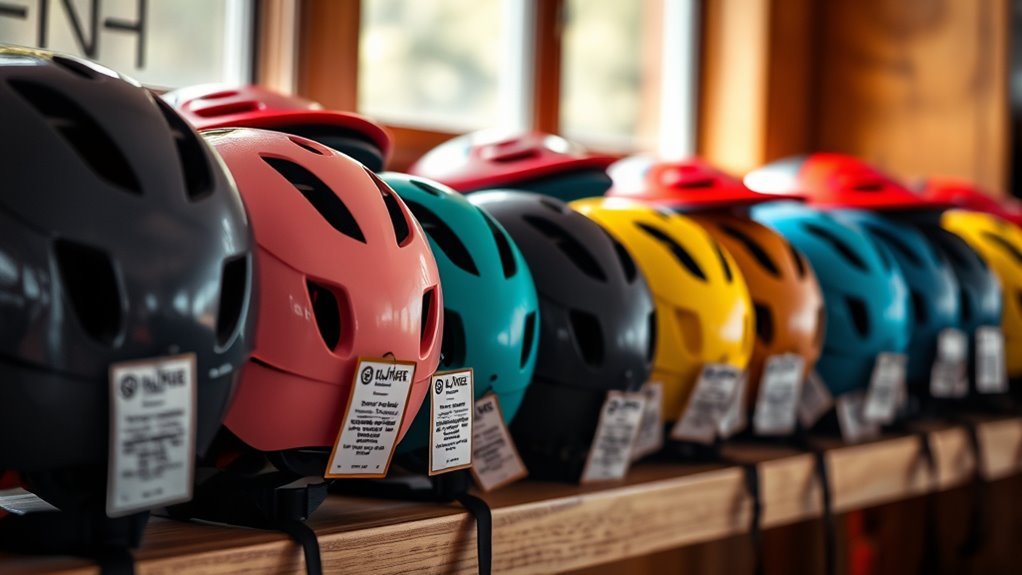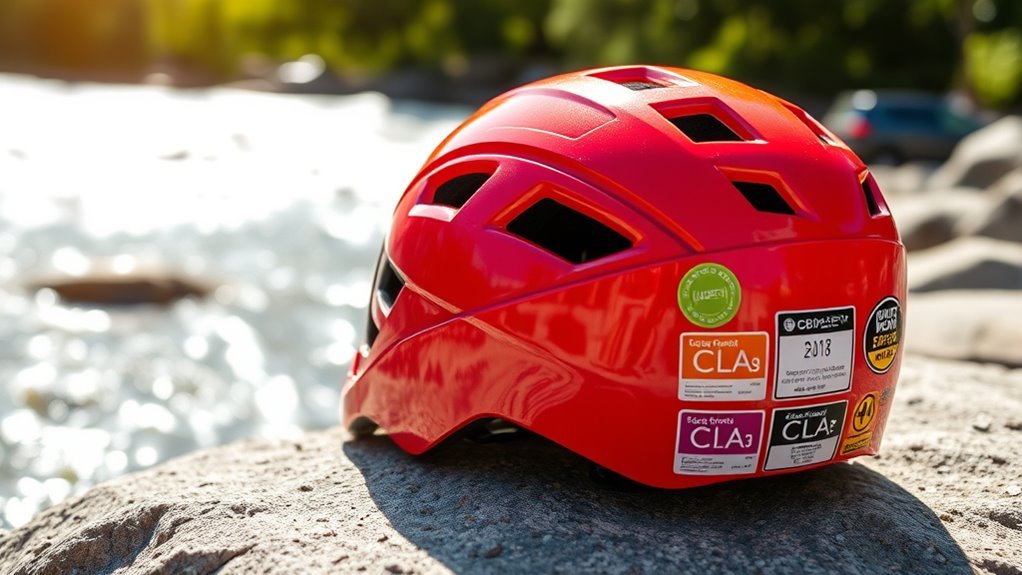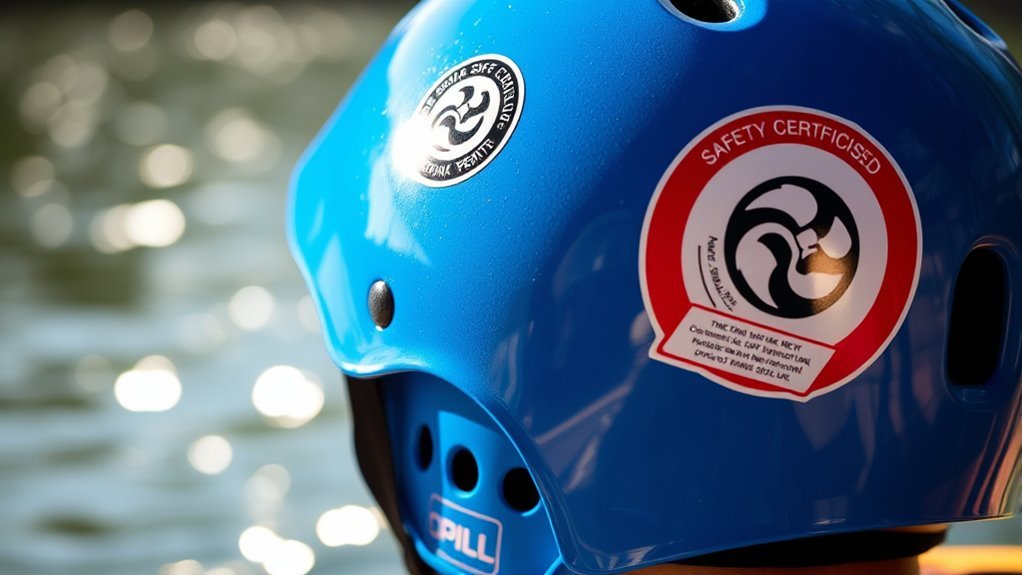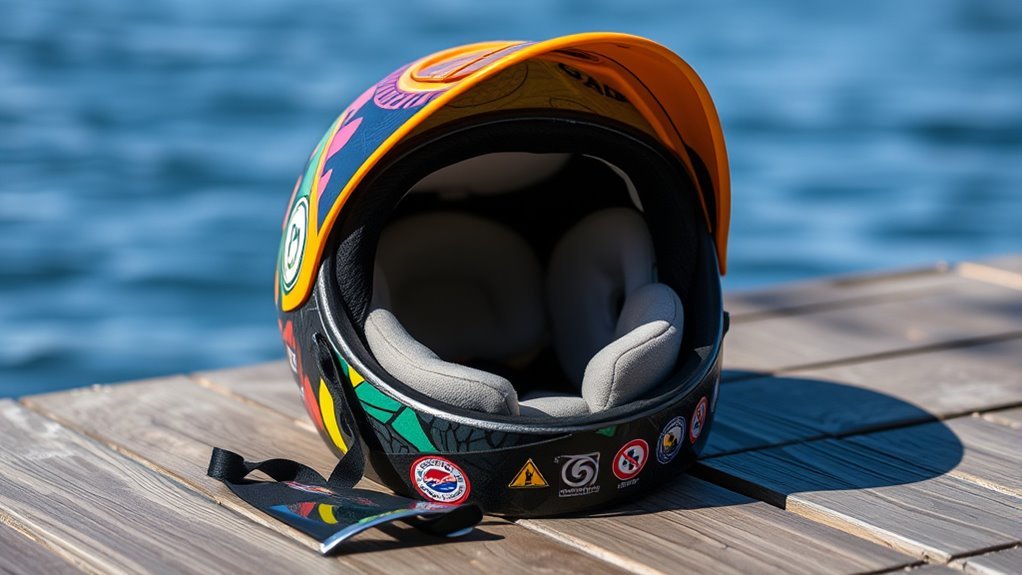Safety Certifications for Kayaking Helmets
Safety certifications for kayaking helmets, such as CE and CPSC, confirm that these helmets adhere to stringent standards for impact resistance. CE certification evaluates materials for durability and performance, while CPSC focuses on helmets’ retention systems for recreational use. Helmets with these certifications usually feature robust constructions and high-density foam for maximum shock absorption. Ensuring your helmet meets these standards is vital for effective protection. There’s more to explore about helmet features and safety considerations.
Importance of Wearing a Helmet While Kayaking

While you might enjoy the thrill of maneuvering through rapids or exploring serene waters, it’s vital to recognize that wearing a helmet while kayaking can greatly mitigate the risk of head injuries. Helmets designed for kayaking provide essential protection against potential impacts from rocks, submerged obstacles, or sudden capsizes. By prioritizing safety awareness, you’re not only safeguarding your own well-being but also setting a responsible example for fellow paddlers. The act of wearing a helmet markedly enhances risk reduction, empowering you to navigate challenging environments with confidence. Modern kayaking helmets are lightweight and designed for comfort, ensuring that protection doesn’t compromise your freedom on the water. So, embrace this essential gear to enjoy your adventures while minimizing hazards.
Overview of Kayaking Helmet Safety Standards

When selecting a kayaking helmet, it’s essential to understand the key safety standards that guarantee reliability and protection. You’ll find that various testing procedures are in place to evaluate the helmets’ performance against impacts and other risks. Additionally, an overview of certification organizations will help you identify which helmets meet the necessary safety criteria.
Key Safety Standards
Understanding the key safety standards for kayaking helmets is essential for ensuring maximum protection on the water. These standards, like EN 1385 and CE certifications, evaluate helmet materials and design to guarantee they can withstand impacts and provide adequate coverage. Helmets must feature robust outer shells, often made of polycarbonate or fiberglass, to absorb force during collisions. The inner foam, typically expanded polystyrene (EPS), plays a crucial role in energy absorption, enhancing kayak safety. Additionally, proper ventilation and adjustable straps are crucial for a secure fit, ensuring helmets stay in place during rapid movements. By adhering to these standards, you can confidently embrace your kayaking adventures, knowing you’re equipped with reliable protection against potential hazards.
Testing Procedures Explained
To guarantee kayaking helmets meet safety standards, rigorous testing procedures are employed that evaluate their performance under various conditions. These helmet testing protocols assess impact resistance, penetration, and retention system efficacy. During safety assessments, helmets are subjected to controlled drops from specified heights onto various surfaces, simulating real-world scenarios. Additionally, they undergo tests for water absorption and buoyancy to confirm functionality in aquatic environments. Each helmet’s straps and buckles are evaluated under stress to verify they remain secure during use. By adhering to these extensive testing procedures, manufacturers can verify that their helmets not only provide adequate protection but also offer the freedom and confidence you need while traversing challenging waters.
Certification Organizations Overview
While various organizations oversee the certification of kayaking helmets, each has distinct standards that address specific safety requirements. The American National Standards Institute (ANSI) and the European Committee for Standardization (CEN) are two primary entities establishing helmet regulations. ANSI focuses on impact resistance and retention systems, while CEN emphasizes both impact performance and additional protective features. These certification processes involve rigorous testing, ensuring helmets meet minimum safety thresholds before being approved for use. You should consider these standards when selecting a helmet, as they directly influence your safety on the water. By understanding the different regulations, you can make informed choices, ensuring you enjoy your kayaking adventures with confidence in your equipment’s reliability.
CE Certification: What It Means for Your Helmet

CE certification signifies that a kayaking helmet meets stringent safety standards set by the European Union, ensuring its reliability in protecting your head during water sports. This certification evaluates various helmet materials, confirming their durability and performance under impact. When you choose a CE-certified helmet, you’re assured that it has undergone rigorous testing for impact resistance, essential for minimizing head injuries in unpredictable conditions. The materials used, such as high-density foam and robust outer shells, are designed to absorb shocks effectively, providing you with the freedom to navigate rough waters confidently. Ultimately, CE certification represents a commitment to quality and safety, allowing you to focus on your adventures without compromising your well-being.
ASTM Standards: Ensuring Impact Protection
When selecting a kayaking helmet, understanding ASTM standards is essential for ensuring ideal impact protection. These standards guide manufacturers in testing helmets for impact resistance, which is vital for your safety on the water. Helmets that meet ASTM standards undergo rigorous testing to evaluate how well various helmet materials absorb and distribute force during an impact. You’ll want to look for high-quality materials, such as polycarbonate and expanded polystyrene, which enhance the helmet’s effectiveness in protecting against head injuries. By choosing a helmet certified under ASTM standards, you’re ensuring that it’s designed to withstand the demands of kayaking, allowing you to focus on enjoying your adventures while minimizing the risks associated with potential impacts.
CPSC Certification: Safety for Recreational Kayaking
CPSC certification is vital for ensuring that kayaking helmets meet safety standards designed for recreational use. You’ll find that the testing procedures focus on impact resistance and retention system effectiveness, which are essential for protecting your head during unexpected incidents. Additionally, helmets with CPSC certification often include features like adjustable straps and enhanced padding, further increasing safety and comfort on the water.
Importance of CPSC Standards
While kayaking can be an exhilarating outdoor activity, ensuring your safety on the water is paramount, and that’s where CPSC standards come into play. CPSC compliance guarantees that helmets meet rigorous safety requirements, vital for protecting you during unexpected accidents or impacts. These standards focus on helmet durability, ensuring they can withstand the rigors of paddling and potential collisions. When you choose a CPSC-certified helmet, you’re investing in your safety, knowing it’s been tested for impact resistance and structural integrity. This certification not only enhances your confidence on the water but also empowers you to embrace your adventurous spirit, all while minimizing risks. Remember, a reliable helmet is your first line of defense against head injuries, making it an essential part of your kayaking gear.
Testing Procedures Explained
Understanding the testing procedures for CPSC certification is essential for anyone serious about kayaking safety. The certification process involves stringent testing methodologies, including impact testing to guarantee helmets can withstand sudden forces. These tests simulate real-world conditions, measuring how well a helmet protects your head during a collision.
| Test Type | Description | Purpose |
|---|---|---|
| Impact Testing | Evaluates helmet’s ability to absorb energy from impacts. | Guarantees head protection. |
| Penetration Test | Measures resistance to sharp objects. | Prevents injury from external hazards. |
| Retention Test | Assesses the helmet’s fit and stability. | Guarantees helmet stays on during use. |
Helmet Features for Safety
When selecting a kayaking helmet that meets CPSC certification standards, it’s important to take into account several key features that enhance safety during recreational use. Look for helmets with high impact resistance, designed to absorb shock from potential collisions or falls. This feature is essential for protecting your head in various water conditions. Additionally, consider ventilation features that allow for airflow, reducing heat buildup and improving comfort during extended use. A well-ventilated helmet not only keeps you cool but also helps maintain focus, critical for safety on the water. Verify the helmet fits snugly yet comfortably, as a proper fit is crucial for ideal protection and performance while you enjoy your kayaking adventures.
EN 1385: The European Standard for Water Sports Helmets
EN 1385 is the definitive European standard that governs the safety and performance criteria for water sports helmets, including those designed specifically for kayaking. This standard outlines the EN 1385 requirements, focusing on essential aspects like impact resistance, retention system strength, and helmet durability. Helmets meeting these standards undergo rigorous testing to guarantee they can withstand the forces encountered during water activities. You’ll find that helmets compliant with EN 1385 are engineered to provide maximum protection while allowing for freedom of movement. Additionally, they often feature designs that enhance comfort without sacrificing safety. When selecting a kayaking helmet, verifying it meets EN 1385 can greatly increase your safety on the water, letting you enjoy your adventures with confidence.
The Role of Testing and Certification in Helmet Safety
When selecting a kayaking helmet, understanding the testing standards and certification processes is essential for ensuring safety. These standards assess the helmet’s ability to withstand impacts and protect your head in various conditions. Certification bodies play an important role in validating these standards, providing assurance that the helmets meet specific safety criteria.
Testing Standards Explained
Although many paddlers might underestimate the importance of helmet safety, understanding testing standards is essential for ensuring ideal protection while kayaking. Testing standards evaluate helmet technology, focusing on parameters like impact absorption and penetration resistance. These standards simulate real-world conditions, measuring how well a helmet can withstand impacts from various angles and forces. By evaluating materials and construction techniques, manufacturers can improve safety features, ensuring that helmets effectively dissipate energy during a collision. Furthermore, rigorous testing helps you identify helmets that meet specific performance criteria, giving you the confidence to choose gear that enhances your freedom on the water. Ultimately, knowing these standards empowers you to make informed decisions, prioritizing safety without compromising your adventurous spirit.
Certification Bodies Overview
While you might focus on the thrill of kayaking, understanding the role of certification bodies in helmet safety is essential for protecting yourself on the water. These organizations establish helmet regulations that guarantee your gear meets specific safety standards. They conduct rigorous testing through certification processes, evaluating a helmet’s impact resistance, penetration, and retention system. By adhering to these regulations, manufacturers can produce helmets that considerably reduce the risk of head injuries during kayaking. Certification bodies also continuously review and update their standards to reflect advancements in materials and technology. When you choose a certified helmet, you’re not just embracing freedom on the water; you’re also securing your safety through proven, reliable protection.
Choosing the Right Helmet Based on Activity Level
Selecting the right helmet for kayaking is essential, especially since your activity level can considerably influence the type of protection you need. Different helmet types cater to various activity suitability, ensuring you’re equipped for your specific adventures.
- Recreational paddling: Look for lightweight helmets that offer basic protection.
- Whitewater kayaking: Choose robust helmets with enhanced impact resistance and a secure fit to withstand potential hits.
- Freestyle and extreme sports: Opt for helmets designed for maximum protection and visibility, often featuring additional padding and adjustable components.
Understanding these distinctions helps you pick a helmet that aligns with your kayaking style, ensuring safety without compromising your freedom on the water.
Fit and Comfort: Key Considerations for Safety
Finding the right helmet goes beyond just activity level; fit and comfort are equally important for ensuring safety on the water. A proper fit adjustment system allows you to customize the helmet’s size, ensuring it stays securely in place during your adventures. Look for helmets featuring an adjustable chin strap and retention system, which further enhances stability. Comfort padding plays a vital role too; it not only provides cushioning but also helps in moisture management, keeping you cool and focused. When selecting a helmet, test different models to find one that conforms to your head shape while offering adequate ventilation. A well-fitted helmet with effective comfort padding can greatly improve your experience and safety while kayaking.
Maintenance and Care for Your Kayaking Helmet
To guarantee your kayaking helmet remains in peak condition, regular maintenance is essential. Implementing effective cleaning techniques and proper storage can greatly extend its lifespan.
Regular maintenance is key to keeping your kayaking helmet in top shape and extending its lifespan.
- Rinse your helmet with fresh water after each use to remove salt and debris.
- Use mild soap and a soft cloth for thorough cleaning; avoid harsh chemicals that may damage materials.
- Store your helmet in a cool, dry place, away from direct sunlight to prevent degradation.
Frequently Asked Questions
How Often Should I Replace My Kayaking Helmet?
You should replace your kayaking helmet every three to five years, even if it looks fine. Helmet lifespan can be affected by UV exposure, impacts, and wear. Staying up-to-date with safety standards is essential for ensuring protection during your adventures. If you’ve had any significant hits or accidents, it’s wise to replace it sooner. Prioritizing your safety means embracing freedom in the water, so don’t compromise on your gear’s integrity.
Can I Use a Bike Helmet for Kayaking?
You shouldn’t use a bike helmet for kayaking. Bike helmets don’t meet the specific safety standards for water sports and lack proper impact protection for potential water-related accidents. They’re designed for different types of impacts and won’t provide the necessary coverage or buoyancy needed in water. For your safety and freedom on the water, invest in a helmet specifically designed for kayaking, ensuring it meets the required safety certifications.
Are There Helmets Specifically Designed for Whitewater Kayaking?
When it comes to whitewater kayaking, you’ll find helmets specifically designed for the sport that’ll keep you safe on the river. These whitewater helmet options feature robust construction, adjustable straps, and enhanced ventilation for comfort. Many have visors to protect against water splashes and side impact protection for added safety. With their unique design features, these helmets are tailored to meet the demands of rough waters, ensuring you can focus on the thrill of the adventure.
What Additional Features Should I Look for in a Helmet?
When choosing a helmet, look for features like ventilation systems, which keep you cool during intense activities. Impact resistance is essential to guarantee your head’s protected from potential injuries. Additionally, adjustable straps enhance comfort and fit, while a lightweight design allows for better mobility. Consider a helmet with a visor to shield your eyes from sun or water spray. These features will help you enjoy your time on the water with greater confidence.
How Do I Properly Clean My Kayaking Helmet?
To properly clean your kayaking helmet, use mild soap and warm water with a soft cloth or sponge. Avoid harsh chemicals that could damage the materials. For stubborn stains, a soft-bristle brush can help. Rinse thoroughly and dry it in a shaded area, avoiding direct sunlight. Regular maintenance tips include checking for cracks or wear after each use and ensuring the straps are secure. Keeping your helmet clean extends its lifespan and enhances your kayaking experience.






